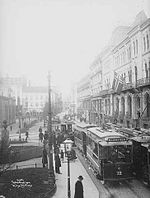Portal:Trains/Selected article/Week 15, 2011
The history of the Oslo Tramway and Oslo Metro in Oslo (Kristiania until 1925), Norway, starts in 1875, when Kristiania Sporveisselskab (KSS) opened two horsecar lines through the city centre. In 1894, Kristiania Elektriske Sporvei (KES) built the first electric street tramways, which ran west from the city centre. Within six years, all tramways were electric. The city council established Kristiania Kommunale Sporveie (KKS) in 1899, which built three lines before it was sold to KSS six years later. Both KSS and KES were taken over by the municipality in 1924, becoming Oslo Sporveier. The company gradually expanded the city tram network, which reached its peak length in 1939. The Holmenkollen Line was the first light rail line, which opened in 1898 and ran west of the city. Later light rail lines in the west were the Røa Line (opened in 1912), the Lilleaker Line (1919), the Sognsvann Line (1934) and the Kolsås Line (1942). From 1928, they ran to the city centre via the Common Tunnel. East of the city, the Ekeberg Line opened in 1917, followed by the Østensjø Line (opened in 1926) and the Lambertseter Line (1957). The light rail lines were built by three private companies, Holmenkolbanen, Ekebergbanen and Bærumsbanen. By 1975, all had been bought by Oslo Sporveier. The Oslo Metro opened in 1966, consisting of a line through the Common Tunnel to Jernbanetorget and the upgraded Lambertseter light rail line. The same year the Grorud Line opened. The next year the Østensjø Line was connected, and in 1970 the Furuset Line opened. The city council decided to close the tramways in 1960, and several lines were closed until the decision was revoked in 1977. In 1987, the Common Tunnel was completed. From 1993, the western lines were upgraded and connected to the Metro, allowing Metro trains to run through the city centre. The Metro's Ring Line was completed in 2006.
Recently selected: Charles Holden - Getå Railroad Disaster - La Stazione

